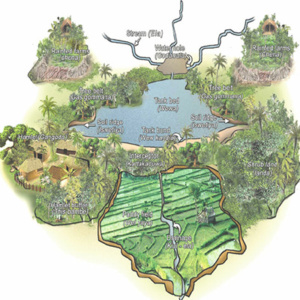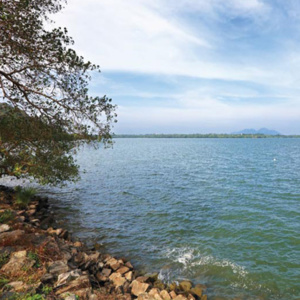

paddy-field-srilanka
yodha-ela


Though many parts of the world are covered with water it is an invaluable resource for the countries where deserts are situated. People who lived in the past had created their settlements adjacent to a water resource or in a river valley. The reason for this was that water was an essential factor for man and there was no irrigation technology at that time. However, during the mediaeval world, irrigation industry was achieving a certain developed level.
A report about the ancient irrigation industry in Sri Lanka, prepared by Mr. G.N. Paranavithana reveals what an excellent development Sri Lanka had gained in connection with irrigation industry in that era. According to him, there were six irrigation construction schemes. They were the (Wewa) tank method, (Amuna) anicut method, (Ulpath) fountain or spring method, (Sathwa) animal method, (Wananthara) forest method and (Bhoomi) earth method.
Out of these systems, tanks, anicuts and fountains did a major role in promoting the irrigation industry. Through the process of storing water into a reservoir called “Wewa”, tanks of small scale and large scale were built by erecting dams across the rivers and streams. This ‘Wewa” is not a mere tank that is filled with water. For building a tank, for collecting water and distributing water various technical devices called ‘ Biso Kotuwa’, ‘Ralapanawa’,’Mohola’ and ‘Diya keta pahana’ were used. These wonderful techniques and devices tell the world what a great irrigation technology Sri Lanka had then.
Even today, there is a large number of tanks of large dimension which contributes to irrigation industry greatly. Basawakkulama, Parakcrama Samudraya, Kalawewa and Minneriya wewa are some of them. Meanwhile, a great number of small scale tanks are regionally located. The carefully collected and stored water which the tanks received from the catchment areas is constantly carried through the canals called ‘Ela” to ‘Rajarata’ and Eastern areas where the rain is very scarce but agriculture is done in abundance. To other areas water is issued when necessary.
Water is issued to canals by opening (Sorowwa) the sluice of the tank. There is another device called (Pitawana) to discharge excessive water the tank receives during the rainy season. The most special creation connected with the tank is its (Biso Kotuwa) slit-trap. Its duty is to reduce the pressure of tank water. This special device which is characteristic only to Sri Lanka’s irrigation technology controls the damages that can be caused when the water flows from the tank and big strong waves strike the tank bund. Some scholars say that it was the queen who interfered with the king’s tough decisions to make them less harmful likewise this special device was named as ‘Biso Kotuwa’.
‘Sangilikandarawa Wewa’ which was built in the second century BC and ‘NaachchaduwaWewa’ which was built in the fifth century BC are said to be of very high irrigation technology. The book named ‘Ancient Sri Lanka’ written by H. Parker, a foreign technologist in1910 has well explained this. U.B. Aushadahamy, in his publication called ‘Wewa’ published in 2003 explains the technical matters connected to the (wewa) tank system, dam of the tank and (Pitawana) spill.
Irrigation Systems created by connecting a number of small tanks with the help of an irrigation canal can be largely seen in the areas of ‘Rajarata’, East and Magam paththuwa in the Southern Province. Through this method, a vast area of land can be irrigated. So it is obvious that the forefathers of this country had taken a long and wide area of land into their consideration when utilizing the irrigation technology.
It is believed that Sri Lanka’s irrigation technology achieved its highest level during the third century BC and it is during this period the Sinhalese, for the first time, endowed the world with the knowhow of conveying water through underground tunnels to a high place and making the first artificial water collecting places on upper elevation. The fact that taking water to the palace on the top of Sigiriya rock using air pressure, humidity and the density of water astonishes even the scientists of the modern world.
With the beginning of the social development together with Buddhist Philosophy and Culture agriculture also became prosperous. Thus the development of irrigation industry was a very important factor. Therefore, the administration back ground for building a tank or two in each and every village was arranged under the theme of Tank and Pagoda, Village and Temple.
The ‘Elahera’ irrigation system created by king Vasabha was a distinguished example for a multi-purpose irrigation system. Because of the multi-purpose irrigation systems which included building a dam across the‘Amban’ River, digging the canals and erecting tanks and dykes, the agriculture in ‘Rajarata’ area remained sustainably. Before the European nations thought of such irrigation systems, the Sinhalese had endowed such constructions to their motherland thousand years ago.
There are many evidences that cities were decorated with attractive ponds in which people could bathe and the used impure water from those ponds was also used for agricultural affairs. The fact that very soft creations like ‘Jaya Ganga’(Yoda ela) which has a slope of 6 inches per mile for flowing water in order to control the damage to the earth is marvellous and wonderful. The invaders knew that the Sinhalese could not be defeated until such creations exist. So they began to destroy the tanks and dams to ruin the agriculture in the hope of weakening the Sinhalese. But the Sinhalese could face the long lasted drought called ‘Baminitiya mahasaaya’ by raising the irrigation industry again.
In the book called ‘ Lakdiwa Warithakshanaya’( Irrigation Technology of Sri Lanka) by K. Daminda Namal Karunarathna, he says that during the reign of king Jayapida in AD 145, Sri Lankan irrigation engineers were sent to Kashmir which is a neighboring country to Sri Lanka for irrigation work according to the book ‘Raja Tharangani’( The History of Kashmir). Sri Lanka had the world’s superb irrigation technology from 2nd century BC to 13th century. Mr. R.L. Brohiyar says Sri Lanka was the first country to build tanks in the world. Once, Brohiyar went to a temple in kurunegala and borrowed and ola leaf book from a Bhikku ( Incumbent of the temple) promising to return it back and left for England. This Brohiyar was a British surveyor. But he never came back to Sri Lanka. That was how the British gained the knowledge of irrigation technology mentioned in that ola leaf book. It is said that the amount of ola leaf books taken by the British from our temples is about 15000. It this knowledge that stolen from our country, the European nations express to the world today as their own knowledge.
When we consider these facts, it very clear that Sri Lanka had a great advanced place in its irrigation technology. Today, the possibility of occurring a drought in a few months after a flood is due to the fact that the standard of our irrigation technology has gone down. Some day, when our present generation absorb the knowledge and abilities of our forefathers and promote the irrigation industry, Sri Lanka will be able to stand as a debtless and proud nation in the world. Hence, all the Sri Lankans should follow and learn the secrets and knowledge of irrigation technology for the betterment of our own. Now it is time to start it island wide at village level.


